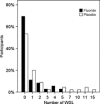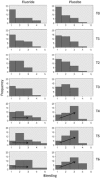A prospective, randomized placebo-controlled clinical trial on the effects of a fluoride rinse on white spot lesion development and bleeding in orthodontic patients
- PMID: 25913893
- PMCID: PMC5029577
- DOI: 10.1111/eos.12186
A prospective, randomized placebo-controlled clinical trial on the effects of a fluoride rinse on white spot lesion development and bleeding in orthodontic patients
Abstract
Demineralizations around orthodontic brackets are a main disadvantage of orthodontic treatment. Several methods have been advocated to prevent their development, such as fluoride rinses or varnishes. In this randomized clinical trial, a fluoride rinse (a combination of sodium fluoride and amine fluoride) was compared with a placebo rinse, to be used every evening after toothbrushing. A total of 81 participants (mean age: 13.3 yr) completed the study (mean treatment period: 24.5 months). Demineralizations, measured using quantitative light-induced fluorescence and the decayed, missing, and filled surfaces (DMFS) index, were assessed before treatment (baseline) and around 6 wk after debonding (post treatment). Bleeding scores were measured at baseline, and during and post treatment. The incidence rate ratio for demineralizations was 2.6 (95% CI: 1.1-6.3) in the placebo group vs. the fluoride group. In the fluoride group, 31% of participants developed at least one demineralization, compared with 47% in the placebo group. Relative to baseline, gingival bleeding increased significantly in the placebo group 1 yr after the start of treatment and onwards. For the fluoride group, bleeding scores during treatment were not different from those at baseline. In conclusion, using a fluoride rinse helps to maintain better oral health during fixed appliance treatment, resulting in fewer demineralizations.
Keywords: caries prevention; fixed orthodontic appliances; fluoride rinse; gingival bleeding; tooth demineralization.
© 2015 The Authors. Eur J Oral Sci published by John Wiley & Sons Ltd.
Figures




References
-
- Ackerman MB. Selling orthodontic need: innocent business decision or guilty pleasure? J Med Ethics 2010; 36: 275–278. - PubMed
-
- Gastel Jv, Quirynen M, Teughels W, Coucke W, Carels C. Longitudinal changes in microbiology and clinical periodontal variables after placement of fixed orthodontic appliances. J Periodontol 2008; 79: 2078–2086. - PubMed
-
- Naranjo AA, Trivino ML, Jaramillo A, Betancourth M, Botero JE. Changes in the subgingival microbiota and periodontal parameters before and 3 months after bracket placement. Am J Orthod Dentofacial Orthop 2006; 130: 275.e17–e22. - PubMed
-
- Socransky SS. Microbiology of periodontal disease – present status and future considerations. J Periodontol 1977; 48: 497–504. - PubMed
Publication types
MeSH terms
Substances
LinkOut - more resources
Full Text Sources
Other Literature Sources
Medical

